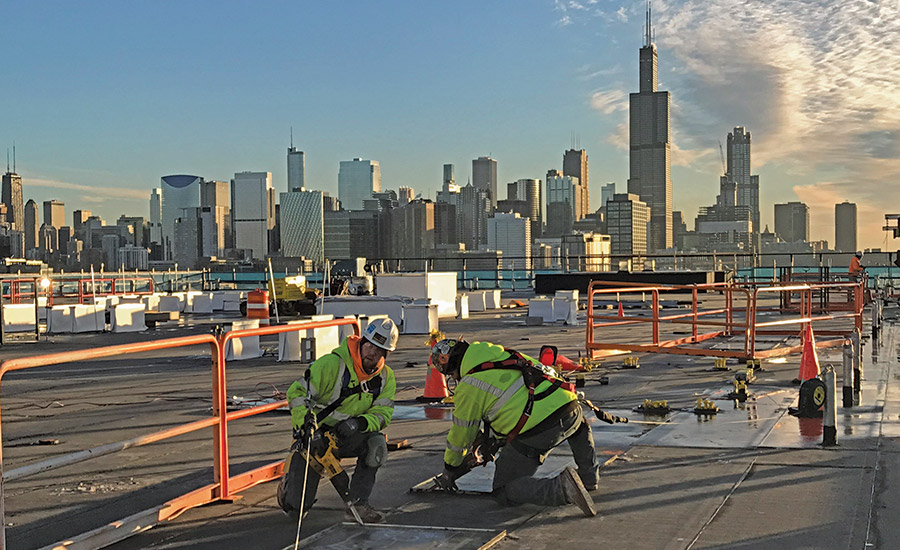Related Link:
ENR Midwest 2023 Top Specialty Contractors
The Midwest’s Top Specialty Contractors are reporting a profitable 2023, driven by strong local demand and growth in opportunities. If anything is holding them back, it’s a tight labor market making it difficult to find enough qualified employees to fill job openings.
“It’s a great time to be a specialty contractor,” says Brian Helm, CEO of Helm Group in Freeport, Ill., a provider of mechanical, civil, plumbing, electrical and other services. Helm Group was last year’s ENR Top Specialty Contractor.
“There's certainly a trend toward megaprojects with an overall value between $500 million up to way north of $1 billion, which puts the largest specialty trade contract in well over the $100-million range,” Helm says. “There are a lot more of these type of projects than we’ve ever seen in the past, and that trend seems to be increasing.”
Graph courtesy of ENR
Of the companies on ENR Midwest’s 2023 Top Specialty Contractors ranking, the largest 25 firms posted $6.48 billion in 2022 regional revenue, an increase of 12% compared to $5.78 billion reported by the top 25 in the previous year. Alternative energy and electric vehicle-related projects fueled the businesses of some companies.
“I would say the biggest opportunity, at least for the Midwest, is the EV battery and EV vehicle initiative. This brings a lot of projects, and they’re megaprojects,” says Koray Ozgenc, CEO of Ben Hur Construction, a steel contractor based in St. Louis.
“We’re involved in an EV battery company with Panasonic. We’re installing 6 million sq ft [of a facility]. We think this trend is going to continue. EV vehicles and batteries are definitely bringing it on,” Ozgenc says.
Tom McCormick, president and CEO of Primoris Service Corp., says his company—whose electrical office is in Inver Grove Heights, Minn.—bought a $20-million-a-year solar business in 2016. This year, McCormick predicts the solar business will earn more than $1.3 billion.
Technology in general is reshaping how specialty contractors do business, says Marty Trainor, co-founder and executive vice president of Ventana, a Chicago-based company specializing in glass and other building facades.
Graph courtesy of ENR
Just being technologically savvy makes a difference, he says. “More and more architecture and other companies rely on BIM [building information modeling] to execute projects. Thankfully, that’s been a strength of ours. We worked on a large project in Detroit. [The team] liked working with us because of the ease of being able to work collaboratively in the building model. We’re strong at it.”
High inflation and rising interest rates were two of the challenges contractors faced.
“I’m 77 and I saw something that I never saw before. I saw a lot of our material costs go up 50% to 60%,” says Howard Mayers, president of Mayers Electric Co. in Cincinnati. “No. 12 wire was $120/1,000 ft. By the time it peaked, it was $207/1,000 ft. We warehouse and we buy things by truckloads, but sometimes we still couldn’t mitigate that problem.”
While rising interest rates and inflation is challenging, in a way it can sometimes be a strength, says Jacob Vogel, chief operating officer of MMC Contractors, an Overland Park, Kan., contractor specializing in mechanical systems.
“Some of the interest rate and product availability issues encourage companies to partner earlier with us to take advantage of the value that we can give when we get out ahead of some of the challenges that they’re facing and plan around them,” Vogel says.
High interest rates are a big issue, agrees Trainor of Ventana. “The interest rates are affecting a lot of projects. Our bidding activity remains as high as it’s ever been, but the pace of awards is very, very slow. We find ourselves having to bid a lot more than typical because we’re not really sure which jobs are going to go and which ones aren’t. So we feel like we can’t afford to miss out.”

A worker with The Helm Group fabricates a pipe, which is the type of specialty contracting work that is flourishing with big projects in 2023, industry executives say.
Photo courtesy of Helm Group
Another challenge for contractors continues to be the shortage of willing and able workers. “The biggest need that we see on the projects that we’re on would be pipefitters and electricians,” says Helm. “We have a great core workforce in both of those trades, and I think the industry overall has a great core workforce, but we just keep needing more and more because of the growth of the industry.”
Ozgenc of Ben Hur sees the issue of employment as an even broader and growing challenge as projects get bigger and more expensive. “I would say that the quality of the tradesmen and that quality of blue collar and even the white collar talent out there is not enough to be able to provide for the demands. There’s so much demand.”
And McCormick notes that it’s not just an issue of finding enough people. Staffing large and fast-paced projects requires that traveling workers swoop in, do the job and leave. While they are there, they have to live. An important part of the evaluation and bidding process has to be considering worker accommodations. “Can we get traveling workers to come there? Is there a place for them to live? It’s hotels. It’s places where guys can get multiple rooms. We don’t do camps. If we have to build a camp, we’ll probably step away from a project because camps take a year to build. By the time you build a camp, the job is over,” he says.
Ventana’s Trainor says, “Building codes are getting more and more stringent. So our systems have to be really high performing. The challenge going forward is who can design systems that meet these performance requirements without adding costs.”



